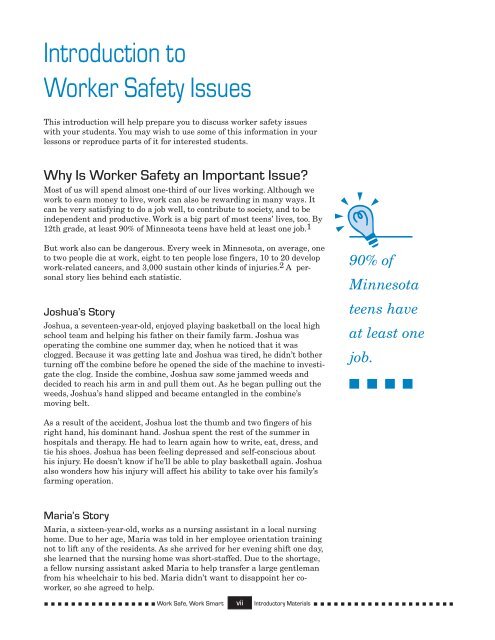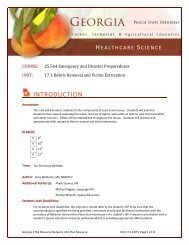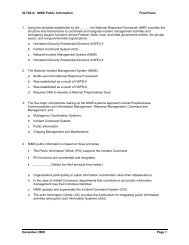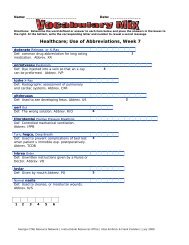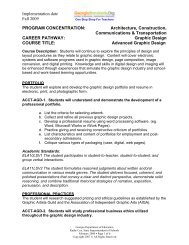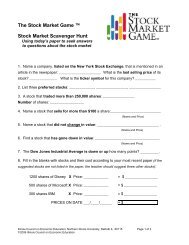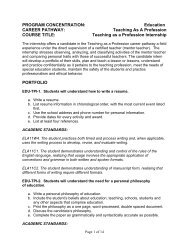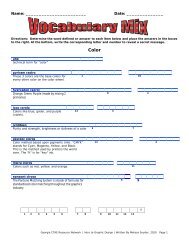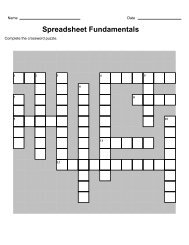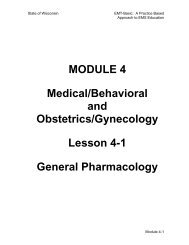WORK SAFE WORK SMART
WORK SAFE WORK SMART
WORK SAFE WORK SMART
You also want an ePaper? Increase the reach of your titles
YUMPU automatically turns print PDFs into web optimized ePapers that Google loves.
Introduction to<br />
Worker Safety Issues<br />
This introduction will help prepare you to discuss worker safety issues<br />
with your students. You may wish to use some of this information in your<br />
lessons or reproduce parts of it for interested students.<br />
Why Is Worker Safety an Important Issue<br />
Most of us will spend almost one-third of our lives working. Although we<br />
work to earn money to live, work can also be rewarding in many ways. It<br />
can be very satisfying to do a job well, to contribute to society, and to be<br />
independent and productive. Work is a big part of most teens’ lives, too. By<br />
12th grade, at least 90% of Minnesota teens have held at least one job. 1<br />
But work also can be dangerous. Every week in Minnesota, on average, one<br />
to two people die at work, eight to ten people lose fingers, 10 to 20 develop<br />
work-related cancers, and 3,000 sustain other kinds of injuries. 2 A personal<br />
story lies behind each statistic.<br />
Joshua’s Story<br />
Joshua, a seventeen-year-old, enjoyed playing basketball on the local high<br />
school team and helping his father on their family farm. Joshua was<br />
operating the combine one summer day, when he noticed that it was<br />
clogged. Because it was getting late and Joshua was tired, he didn’t bother<br />
turning off the combine before he opened the side of the machine to investigate<br />
the clog. Inside the combine, Joshua saw some jammed weeds and<br />
decided to reach his arm in and pull them out. As he began pulling out the<br />
weeds, Joshua’s hand slipped and became entangled in the combine’s<br />
moving belt.<br />
90% of<br />
Minnesota<br />
teens have<br />
at least one<br />
job.<br />
As a result of the accident, Joshua lost the thumb and two fingers of his<br />
right hand, his dominant hand. Joshua spent the rest of the summer in<br />
hospitals and therapy. He had to learn again how to write, eat, dress, and<br />
tie his shoes. Joshua has been feeling depressed and self-conscious about<br />
his injury. He doesn’t know if he’ll be able to play basketball again. Joshua<br />
also wonders how his injury will affect his ability to take over his family’s<br />
farming operation.<br />
Maria’s Story<br />
Maria, a sixteen-year-old, works as a nursing assistant in a local nursing<br />
home. Due to her age, Maria was told in her employee orientation training<br />
not to lift any of the residents. As she arrived for her evening shift one day,<br />
she learned that the nursing home was short-staffed. Due to the shortage,<br />
a fellow nursing assistant asked Maria to help transfer a large gentleman<br />
from his wheelchair to his bed. Maria didn’t want to disappoint her coworker,<br />
so she agreed to help.<br />
Work Safe, Work Smart<br />
vii<br />
Introductory Materials


